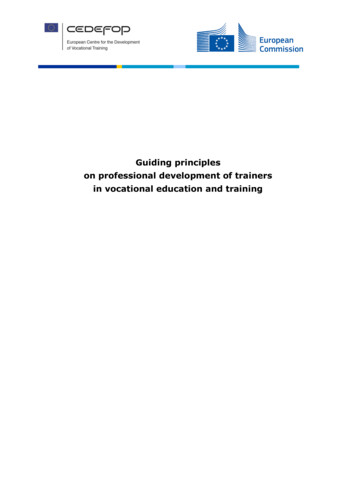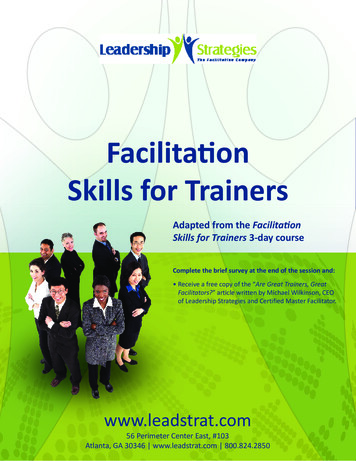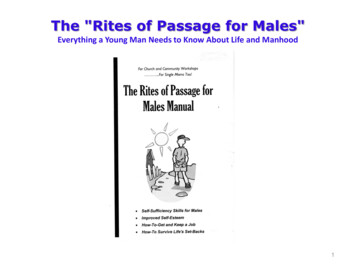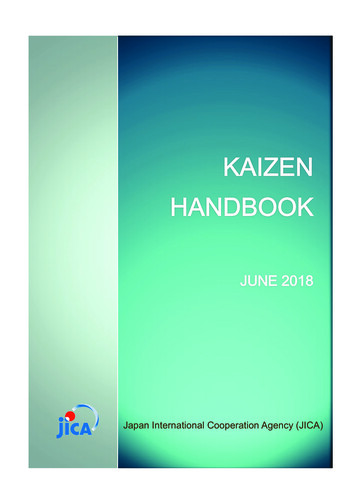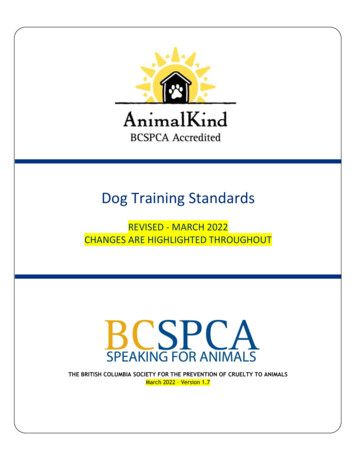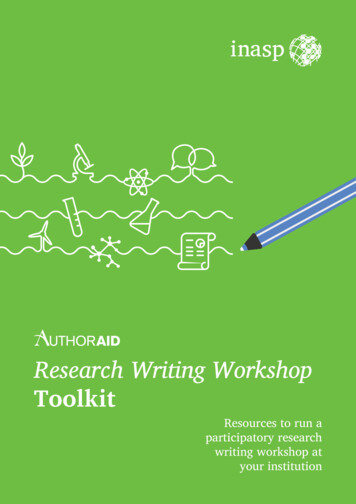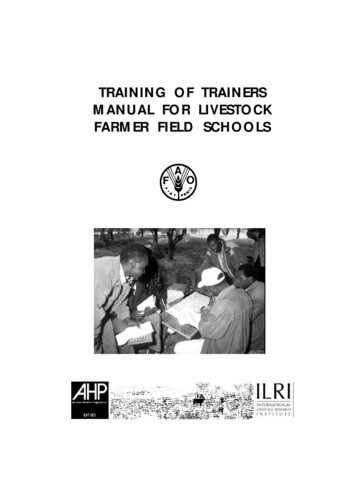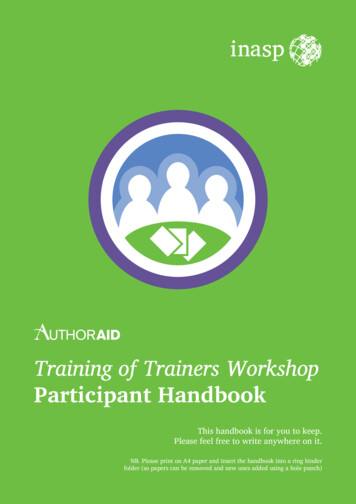
Transcription
Training of Trainers WorkshopParticipant HandbookThis handbook is for you to keep.Please feel free to write anywhere on it.NB. Please print on A4 paper and insert the handbook into a ring binderfolder (so papers can be removed and new ones added using a hole punch)
Example participant agenda: training of trainersworkshop (of research writing workshops)At the end of this three-day training workshop, participants should be able to: Summarize the principles of adult learning and relate them to that of their learners and their owntraining practice. Set learning outcomes, that require various levels of thinking skills, appropriate to the researchwriting workshop context. Use assessment for learning when delivering research writing workshops. Use techniques and strategies that encourage active learning and higher level thinking, within theresearch writing workshop context.Day oneTimeLengthSession heading Session contentSession summary9:00-10:3090 mins1. Introduction Welcomeand concept of aand generalworkshopintroductionsThe purpose of this session is to giveus a sense of the ‘geography’ of theworkshop but also to agree on howwe want to work together, and whatwe want in the learning environmentand from each other in order to feelsafe, ready and free to learn. We willalso examine some of the terminologyassociated with training and learningand the implications for you as existingor future trainers of research writingworkshops. Warm up activity Housekeeping &introduction toworkshop LearningcontractDifferences betweena workshop and anacademic courseDifference betweentraining, facilitating,presenting10.3011.0030 minsBreak11.0012.1575 mins2. Approachesto trainingWhat sort of trainerare they?Less to more learnercentred trainingapproaches12.1513.1560 minsLunch13.1514.1560 mins3. Adultlearningprincipleswww.inasp.info www.authoraid.infoAdult learningprinciplesFN 2In this session we start to unpack theexpectations, perceptions and beliefsthat different trainers can have towardstraining and learning. We then go on toconsider what we do, expect and believeas trainers, some of the underlyingreasons why and what type of trainerswe ultimately want to be. This is anopening session and themes raised herewill be revisited throughout the courseof the workshop.Part of being an effective trainer involvesunderstanding how adults learn best.Andragogy (adult learning) is premisedon at least five crucial assumptionsabout the characteristics of adultlearners that are different from thosemade about child learners on whichtraditional pedagogy is based. We willlook at the five principles, pioneered byMalcolm Knowles (1973).TRAINING OF TRAINERS TOOLKIT
TimeLengthSession heading Session contentSession summary14.15-15.1560 mins4. The activePersonal experiencesand selfof teaching and/ordirected learner training good studentsand/or learnersPeople learn best when they takeresponsibility for their own learning.They implement strategies that helpthem get the maximum value out of aparticular learning experience, ratherthan simply sitting back and expectingthe trainer to pour knowledge intotheir heads. In this session we startto investigate what an active learnermight look like and start to considerhow we as trainers can develop suchlearners.What does an activeand self-directedlearner look like15.15-15.3030 minsBreak15.3016.0030 minsReflection andreviewTimeLengthSession heading Session content9:00-9:3030 minsMorning reviewRecap of day one andoverview of day twoThe morning sessions are anopportunity to revisit the ways weagreed to work together and whatwe wanted to see in this particularlearning environment. We will brieflyshare from the day before whatwe learned and how, any follow-upquestions and feedback on the overalltraining experience so far.9.30-10.3060 mins5. Encouragingand managingactive learningActive training andlearning strategiesand/or techniquesBuilding on the session the day before,we will examine how we as trainers canorganize learning so as to encouragemore active learning and deeperthinking amongst our participants.We will establish a list of ‘quick wins’when it comes to making good activelearning happen, particularly whenworking with medium to large groupsof learners.Exit cards and/or group Reflection is important and we will takereflectionthis opportunity to reflect on what hasworked well (or not), why and what wecan take away from the day.Day twoEvaluating activelearning strategies andtechniques10.3011.0030 minsBreak11.00-12.0060 mins6. Organisingand managinggroup workWhy use small grouplearningMethods for forminggroupsMethods for reportingback on group work12.0013.0060 minsSession summaryIn this session we consider waysto organize participants so as toencourage their involvement andmotivation. It is practical in nature,and the outputs of this session willbe a useful resource to refer back to,particularly when at the design andplanning stage of a research writingworkshop.Lunchwww.inasp.info www.authoraid.infoFN 3TRAINING OF TRAINERS TOOLKIT
TimeLengthSession heading Session contentSession summary13.00-13.4545 mins7. FormulatingWhy set intendedintendedlearning outcomeslearningSetting good enoughoutcomes (ILOs)ILOsIn this session, we drill down to what wewant our learners to know and be ableto do. You may have come across theuse of taxonomies as a way to formulatethe wording of ILOs, notably the work ofBloom et al. (1956) and Anderson andKrathwohl (2001). These taxonomies area useful guide in helping us arrive at fitfor-purpose learning outcomes.Examples ILOs ofvarying quality andreasons why13.45-14.3045 mins8. Assessmentfor learningHow to useassessmentfor learningTechniques tomeaningfully assesslearning14.3015.0030 minsBreak15.0016.0060 mins9. Challenges to Common challenges toactive learningactive learning16.0016.3030 minsReflection andreviewWe could spend days talking aboutsummative assessment and itsshortcomings. We will focus onformative assessment and strategiesfor making it manageable. Formativeassessment is often referred to as‘assessment for learning’ as opposed to‘assessment of learning’ (summative)and can be a powerful tool.Some of you may have alreadyexperienced a challenge related toactive learning in a training or teachingcontext. These aspects are importantbecause they can influence howengaged an individual or group canbe and the quality of their learningexperience. We will identify togethersome techniques and strategies to helpin establishing and maintaining activelearning within the workshop context.Exit cards and/or group Reflection is important and we will takereflectionthis opportunity to reflect on what hasworked well (or not), why and what wecan take away from the day.Day threeTimeLengthSession heading Session content9:00-9:1515 minsMorning reviewRecap of day one andoverview of day twoRefresh learningcontract9.15-10.0045 mins10A. Trainingpractice (finalpreparation)10.00-12.00120mins10B. Trainingpractice (andfeedback)www.inasp.info www.authoraid.infoSession summaryThe morning sessions are an opportunityto revisit the ways we agreed to worktogether and what we wanted to see inthis particular learning environment. Wewill briefly share from the day beforewhat we learned and how, any follow-upquestions and feedback on the overalltraining experience so far.We will have the opportunity to ‘try out’and then reflect on some techniquesdesigned to encourage learners tobe more collaborative, active andindependent in their learning. Youwill be invited to draw on trainingcontent of your choice from theresearch writing workshop youDelivery of 15 minutetrain on/will train on and thentraining sessions, while try these techniques out for size inother groups observe,a supportive and non-judgementalusing a checklist tolearning space.provide peer feedback.Design of 15 minutetraining sessions,drawing on researchwriting workshopcontent and one activelearning technique ofchoice.FN 4TRAINING OF TRAINERS TOOLKIT
TimeLengthSession heading Session contentSession summary12.0012.4545 minsLunch12.45.14.0075 mins10B. Trainingpractice (andfeedback) cont.Delivery of 15 minuteCont.training sessions, whileother groups observe,using a checklist toprovide peer feedback.14.0014.4545 mins11. Researchwritingworkshop walkthroughIntroduction to theresearch writingworkshop packageSample session fromresearch writingworkshopUsing and adapting theworkshop package14.45-15.0015 minsBreak15.0016.0060 mins12. Workshopclosing Review of theworkshop Workshopevaluation Workshop closingcirclewww.inasp.info www.authoraid.infoFN 5The final session is about bringingeffective closure to the workshop. Itis a time to recap on the highlights ofwhat happened, reinforce learning,celebrate one another’s efforts andreflect on how we will turn the learninginto action in our future trainingworkshops.TRAINING OF TRAINERS TOOLKIT
Session 1:Introductionand concept ofa workshopwww.inasp.info www.authoraid.infoPH 6TRAINING OF TRAINERS TOOLKIT
Pre-workshop reflection task What are the key elements of active learning in your view? What implications does active learning have for you as a trainer of face to face workshops?This short film discusses what active learning is and provides examples of how active learning can beused in both face to face and online classes www.youtube.com/watch?v UsDI6hDx5uIPoints of reflection:WHEN IS A LEARNING CONTRACT AT ITS MOST EFFECTIVE?When the agreed ways of working: are simple and direct are limited in number are posted on the wall in order for the group to refer back to them to make sure they are beingfollowed are enforceable can be shared with “new” people in less than 60 seconds anything else?HOW CAN YOU DEVELOP PSYCHOLOGICAL SAFETY WITHIN THE WORKSHOPS YOU TRAINOR WILL BE TRAINING ON?‘After years of intensive analysis, Google discovers the key to good teamwork is being nice’The concept of “psychological safety” is a model of teamwork in which members have a sharedbelief that it is safe to take risks and share a range of ideas without the fear of being -isbeing-nice/?utm source facebook&utm campaign HBR&utm medium socialwww.inasp.info www.authoraid.infoPH 7TRAINING OF TRAINERS TOOLKIT
What are the key differences between a workshop and anacademic course?Workshopwww.inasp.info www.authoraid.infoAcademic coursePH 8TRAINING OF TRAINERS TOOLKIT
Blog: What is the Difference Between Training,Facilitating, and PresentingBefore the session print out the blog: efinition of a ‘workshop’A workshop has been defined as “a usually brief, intensive educational program for a relatively smallgroup of people in a given field that emphasizes participation in problem solving efforts”. Traditionally,this educational method provides learners with an opportunity to exchange information, practice skills andreceive feedback, and when properly designed, is a time- and cost-efficient method of actively involvingparticipants in the learning process. Workshops are popular because of their inherent flexibility andpromotion of principles of experiential and adult learning. They can also be adapted to diverse settings inorder to facilitate knowledge acquisition, attitudinal change or skill p.info www.authoraid.infoPH 9TRAINING OF TRAINERS TOOLKIT
Session 2:Approachesto trainingwww.inasp.info www.authoraid.infoPH 10TRAINING OF TRAINERS TOOLKIT
www.inasp.info www.authoraid.infoPH 11TRAINING OF TRAINERS TOOLKITSome of the learners are not up to it and it is awaste of my time and resources.If uptake is so varied, I must look at the way inwhich we are working. Is the work pitched at theright level? Am I giving them enough time andopportunity to take in the new information andskills?Some learners have very different levels ofuptake. What is important is to avoid widediscrepancies by encouraging the learners tomonitor their own learning and support andquestion each other as they go along.Some learners have very different levels ofuptake. I do my best to identify what the barriersto learning are and how the learners mightimprove.Obviously some do better than others but that isdown to their work rate and intelligence. Somelearners get it while others don’t really that’s life!Learners are given as many chances as I can givethem to encourage learning and we believe thatmost or all of them can succeed.I need to present the learning in a meaningfulway and ensure that learning has taken place.I often work in difficult environments and we justhave to make the best of it.I encourage learners to make sense of thematerial and I use different media to get the keylearning points across.I often work in difficult environments and I workwith learners to come up with ways to make thelearning environment in its widest sense ‘fit forlearning’.I often work in difficult environments and try mybest to provide a positive climate for learningboth in terms of the physical environmentbut also the emotional and psychologicalenvironment.I give learners lots of notes and they go away andlearn it so that they can pass on their knowledge.I train large groups and my starting point is thelearner: what prior knowledge, experience andskills do they already have. How can they get thebest out of their engagement with the learning?Trainer 3I train large groups and the challenge is topresent the material in a comprehensible andinteresting way. I have to be selective in mychoice of material and activities.Trainer 2I train large groups and I have fixed content tocover. I aim to cover all the points in the timeavailable. The activities and materials are therefor me to use.Trainer 1What sort of trainer are they?
www.inasp.info www.authoraid.infoPH 12TRAINING OF TRAINERS TOOLKITRoleMaterial to be studiedProblemsBlameN.B. Learning takes place through the active behaviour of the student: it is what he (sic) does that he learns, not what the teacher does’. Tyler, R.W. (1949). Basic principles of curriculum and instruction.Chicago: University of Chicago Press, p.63.321Starting point If anyone is to blame for the failure, who is it in each case? How does the trainer deal with problems and failures? How does the trainer perceive what is covered in the training? How does the trainer understand their role? Who is the trainer centring their training on?Look at the table and work out what the key differences are between the different trainers:What sort of trainer are they?
www.inasp.info www.authoraid.infoPH 13TRAINING OF TRAINERS TOOLKITI think it’s impossible to train large groups all the time. There are alwaysopportunities for pair and group work even in large sessions.Of course I need some prescribed content but only as a starting point. Forlearning outcomes to be met however I weave new content in during thecourse of the training.I create and prioritize opportunities for discussion above the delivery ofinformation during the course of the training.I give presentations because the numbers are too high and it is the onlyopportunity.I expect learners to follow me and my recommendations.I think the best learners sit quietly and take notes.I believe my role is as primary information giver and as primary assessor.I think what is in the training guide is what really matters.I don’t have much time and space for discussion during the course of thetraining.I’m paid to deliver content so I stick to the script.II.III.IV.V.VI.VII.VIII.Learners know a great deal. What we need to do is build on their previousknowledge.I’m not happy just giving presentations I need to find different ways toengage learners and stimulate their learning.My view is that learners on the whole know nothing. It is my job to getthem up to speed on content.I believe a trainer should go in, do the presentations plus a spot ofdiscussion and then wrap up.IX.X.I’m not paid to deliver content, I train or more specifically facilitatelearning, it’s about more than just the content.I feel strongly that learners must recognize that they will do better if theycollaborate and learn from each other.I encourage the learners to ‘flip the learning’ and read the material inadvance and prepare questions.My view is that learners must always question what I tell them andassimilate and accommodate new information and skills.I have to get across to learners that knowledge changes all the time andthat I and they must stay current and relevantI use the same notes every year and expect learners to learn what I tellthem.I.From less centred on the learner to more centred on the learner spectrum
Point of reflection:What factors can determine where you place yourself on this spectrum (from less centred on thelearner to more centred on the learner)?www.inasp.info www.authoraid.infoPH 14TRAINING OF TRAINERS TOOLKIT
Session 3:Adult learningprincipleswww.inasp.info www.authoraid.infoPH 15TRAINING OF TRAINERS TOOLKIT
TASK:a) Highlight the keywords.b) Think of specific examples, drawing from your own experience of training or teaching, to illustrateat least two different statements.c) Refer back to the table entitled ‘From less centred on the learner to more centred on the learner’in session two of the handbook. Identify the statements which, in your view, overlap with one ormore of the adult learning principles.Five principles of adult learning1. Personal benefit. Adult learners must be able to see the personal benefit of what they learn, andhow it satisfies needs they have. They are motivated to learn if the learning: Solves or avoids a problem for them. Provides an opportunity or increased status. Leads to professional or personal growth.2. Experience. Adult learners come to each learning event with a unique background of knowledgeand experience. They are motivated to learn if the learning: Involves them in sharing what they know. Builds on what they know. Validates their expertise.3. Self-direction. Adult learners are self‐directed and must have some control over what they arelearning. They are motivated to learn if they can: Take charge of their learning and make decisions about the content and process. Contribute to the learning of their co‐learners. Have some degree of independence in the learning process.4. Application and action. Adult learners are busy, practical, and learn by doing. They learn bestwhen: There is immediate application for the learning. They participate actively in the learning process. They can practice new skills or test new knowledge before leaving a learning session.5. Learning preferences/styles. Adult learners approach learning in a variety of ways, from hands‐on to using their eyes, ears, and/or logic to anchor new skills and knowledge. They learn best when: The learning taps into a mix of learning styles that fit their preferences. Multiple means are used to represent the material being learned.(Adapted from Lela Vandenberg “Facilitating adult learning” available at:od.msue.msu.edu/uploads/files/PD/Facilitating Adult Learning.pdf)www.inasp.info www.authoraid.infoPH 16TRAINING OF TRAINERS TOOLKIT
Session 4:Encouragingand managingactive learningwww.inasp.info www.authoraid.infoPH 17TRAINING OF TRAINERS TOOLKIT
Why do active learning?Reviews of the literature (Prince, 2004; Michael, 2006) show extensive empirical support for activelearning. Several research studies demonstrate the positive impact active learning can have upon studentlearning outcomes: Increased content knowledge [and deeper learning], critical thinking and problem-solving abilities,and positive attitudes towards learning in comparison to traditional lecture-based delivery(Anderson et al, 2005). Increased enthusiasm for learning in both students and instructors (Thaman et al., 2013). Development of graduate capabilities such as critical and creative thinking, problem-solving,adaptability, communication and interpersonal skills (Kember & Leung, 2005). Improving students perceptions and attitudes towards information literacy (Deltor et al., 2012). Check out the latest research on active learning featured in Active Learning in Higher Education.Despite the wide range of positive benefits listed above, Michael (2006) articulates an important point:“active learning doesn’t just happen; it occurs in the classroom when the teacher creates a learningenvironment that makes it more likely to arning/why-do-active-learningScenario AA colleague, very new to training on research writing workshops, has come to you for some ‘quick win’ideas on how to develop more active and self-directed learners within their training sessions. The averagenumber of participants in the sessions ranges from 20-40 adults. Their normal routine is to deliver lecturessupported by PowerPoint slides, with the odd question thrown in. They have noticed that many of thelearners appear disinterested, unmotivated and even frustrated at times. They recently heard from aclose colleague that the learners trained so far have not really retained, nor even tried to apply what wascovered in the research writing workshops that they ran.www.inasp.info www.authoraid.infoPH 18TRAINING OF TRAINERS TOOLKIT
Session 5:Organizingand managinggroup workwww.inasp.info www.authoraid.infoPH 19TRAINING OF TRAINERS TOOLKIT
How group size affects functionSizeTask functionAffective functionsIndividualsPersonal reflection:Personal focus increases ‘safety’: generating personal data personal focus means positive start brings a sense of ownershipPairs/threesInstant buzzes, turning to neighbours:Builds a sense of safety: sharing interpretations builds sense of confidence by activeinvolvement (self-belief) good for basic communications skillspractice (e.g. listening, questioning,clarifying)Fours or atmost fives lays foundation for sharing and cooperating in bigger group good size for co-operative working reticent members can still take partGroup work:Increased safety for quiet members: criticizing ideas at lower end of range still difficult forthem to ‘hide’, but risk increases withsize usually sufficient number to allocateroles and responsibilities, thereforewider range of work can be tackled strong can still enthuse the lessconfident size still small enough to avoidsplintering than 10Task focus becomes difficult: size hinders discussion but activitiespossible, e.g. using purposeful subgroups where only a few have relevantexperience of topic or for sharing bypeers where participants would rather keepquietwww.inasp.info www.authoraid.infoPH 20Difficulties in maintaining supportiveclimate: ‘hiding’ becomes common ‘dominance’ temptation and leadershipstruggles a risk divisive possibilities with spontaneoussplintering into sub-groupsTRAINING OF TRAINERS TOOLKIT
Methods of forming groups and their advantages anddisadvantagesTASK:a) Decide which of the four methods for forming groups matches which set of statements andcomplete the first column.b) Write any additional points, which came out of your discussions in the second column.Method I: Useful for learning points of view, knowledge, experience and skills of participantsfrom other backgrounds. Knowledge that participants who are new, junior, young etc. have been deliberatelymixed can add to their voice and other’s listening (if stated at start). Method II: Good for commitment, motivation and exercising choice. Participants may stick with friends and colleagues. Method III: Good as mixers early on - quick, simple and fun. Physical activity, wakes people up. Leads well into group discussions and other activities. Good for graveyard hour in the afternoon. Method IV: Useful where composition and chemistry are critical to a task, difficult groupmembers and/or together over an extended period. Appropriate mix of disciplines, genders, experience, local knowledge and language etc. Can lead to resentment and requests to change groups. www.inasp.info www.authoraid.infoPH 21TRAINING OF TRAINERS TOOLKIT
Scenario BThe same colleague, who you helped previously, with recommendations for quick and easy activelearning strategies and techniques, is now in a much better place mentally. They are more confidentand starting to see more positive learning outcomes amongst the learners on the research writingworkshops they are running. In fact the learners are so engaged during sessions and during thegroup tasks in particular, that the trainer is now struggling to gather feedback from all the groups,at the end. They often end up running out of time and worry that some learners are starting to feelignored or that their ideas are not being taken seriously. The trainer also doesn’t want to develop areputation amongst training colleagues of always running late.www.inasp.info www.authoraid.infoPH 22TRAINING OF TRAINERS TOOLKIT
Session 6:Formulatingintended learningoutcomes (ILOs)www.inasp.info www.authoraid.infoPH 23TRAINING OF TRAINERS TOOLKIT
Useful verbs for outcome-level statementsThe cognitive domain involves knowledge and the development of low to higher level thinking skills.There are six major categories, which are listed in order below, starting from the simplest skill to the mostcomplex. The categories can be thought of as degrees of difficulties. That is, the first ones must normallybe mastered before the next ones can take place.Anderson & Krathwohl’sTaxonomy: cognitive domainDescriptionUseful verbs for outcomelevel statementsRememberingRecalling previous learnedinformation.Example: Describe the keyethical issues in research andpublishing.Key words: define, describe,identify, label, list, match, name,outline, recall, recognizeUnderstandingComprehending the meaning,translation and interpretation ofinstructions and problems. Statea problem in one's own words.Example: Explain in one's ownwords what kind of mind set oneshould have before embarking onresearch communication.Key words: conclude, classify,defend, distinguish, explain,give an example, infer, interpret,paraphrase, predict, summarizeApplyingAnalysingEvaluatingUsing a concept in a newsituation or unprompted use ofan abstraction. Applying whatwas learned in the training spaceinto novel situations in the workplace.Example: Prepare a researcharticle following the IMRADformat.Separating material or conceptsinto component parts so thatits organizational structure maybe understood. Distinguishingbetween facts and inferences.Example: Differentiate betweenethical and unethical behaviourin research communication.Making judgments about thevalue of ideas or materials.Example: Evaluate whether ajournal is suitable for publishingyour research.Key words: apply, carry out,demonstrate, modify, predict,prepare, provide, relate, respond,show, solve, useKey words: analyse, breakdown, compare, contrast,deconstruct, differentiate,discriminate, distinguish,examine, identify, illustrate,infer, organize, outline, relate,selectKey words: appraise, argue,check, criticize, critique, defend,evaluate, interpret, judge, justify,monitor, reflect, summarize,supportCreatingwww.inasp.info www.authoraid.infoBuilds a structure or patternfrom diverse elements. Put partstogether to form a whole, withemphasis on creating a newmeaning or structure.PH 24Example: Write a working titleand abstract for a researchpaper.Key words: assemble, compile,compose, create, devise, design,generate, plan, produce, revise,tell, writeTRAINING OF TRAINERS TOOLKIT
Formulating an intended learning outcome the action verb at the appropriate level of understanding or performance intended. the topic content the verb is meant to address, the object of the verb in other words. the context of the content discipline in which the verb is to be deployed.e.g. By the end of the workshop, participants will be able to describe the key ethical issues in researchand publishing.A short checklist to help set the right learning outcomes1. Complete the phrase, “By the end of this workshop (or session), participants/learners will be ableto ”.2. Start with an action verb that specifies the level of learning expected.3. Avoid terms that are too vague for assessment such as know, understand, learn, appreciate, and beaware of.4. State the subject of the knowledge, skills, or values/attitudes to be demonstrated.5. Is specific enough to be observable, measurable, and capable of being assessed.6. Has a breadth and depth that will not limit flexibility and adaptability in the workshop plan.7. Is concise, direct, clearly stated and understandable by multiple audiences.www.inasp.info www.authoraid.infoPH 25TRAINING OF TRAINERS TOOLKIT
Examples of ILOs of varying quality and the reasons whyTASK:a) First match each learning outcome on the slide (A-D) to option 1, 2, 3 or 4 below.b) Then complete the analysis column, explaining why you have matched the learning outcome tothat particular option.Learning OutcomeAnalysisOption 1:Not an outcomeOption 2:VagueOption 3:Less vagueOption 4:Specificwww.inasp.info www.authoraid.infoPH 26TRAINING OF TRAINERS TOOLKIT
Session 7:Assessment forlearningwww.inasp.info www.authoraid.infoPH 27TRAINING OF TRAINERS TOOLKIT
Assessment for learning (formative assessment)When the cook tastes it, it is formative, when the customer tastes it, it is summative.A. How do trainers determine what type of formative assessment strategy to use? Trainers need to determine what aspect of participant learning they want to assess. They then needto consider the learning preferences of their participants. Formative assessment strategies can be given to participants individually, as pairs, in small groups,or as a group. Trainers should not rely on one type of assessment strategy. A var
their heads. In this session we start to investigate what an active learner might look like and start to consider how we as trainers can develop such learners. 15.15 -15.30 30 mins Break 15.30-16.00 30 mins Reflection and review Exit cards and/or group reflection Reflection is important and we will take this opportunity to reflect on what has

